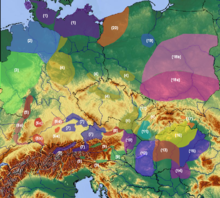 | |
| Geographical range | Hungary, Slovakia |
|---|---|
| Period | Bronze Age |
| Dates | 20th-18th centuries BC |
| Type site | Nagyrév |
| Preceded by | Nagyrév culture |
| Followed by | Ottomány culture, Mad'arovce culture |

The Hatvan culture was a Hungarian Bronze Age archaeological culture that succeeded the Nagyrév culture.[1] The earliest identified settlements are located in the Cserehát Hills, later expanding into northern Hungary and the Tisza valley, and the Tiszazug area in Eastern Hungary.[2] The end of Hatvan culture was associated with the expansion of the Ottomány culture.
- ^ Kulcsár, Gabriella (2003). "The Early Bronze Age". In Visy, Zsolt (ed.). Hungarian Archaeology at the Turn of the Millennium (PDF). Ministry of National Cultural Heritage. p. 145. ISBN 9638629185.
Named after the Hatvan–Strázsahegy site in northern Hungary where the culture evolved, the Hatvan culture was a neighbour of the Nagyrév culture. The Hatvan culture evolved from the intermingling of earlier local communities and eastern population groups. The earliest upland settlements of the culture are known from the Cserehát Hills, lying between the Hernád–Bodrog–Sajó rivers; the culture later expanded into northern Hungary and the Tisza valley down to the Körös rivers, as well as eastern Hungary, including the Tiszazug area. Over one hundred Hatvan settlements fortified with ditches and/or ramparts, often lying at distances of no more than 5–10 km from each other, were established in the wake of this expansion. The Hatvan communities brought an end to the Nagyrév culture, and rebuilt the destroyed Nagyrév settlements according to their own tradition.
- ^ "Archived copy" (PDF). Archived from the original (PDF) on 2018-12-22. Retrieved 2018-05-17.
{{cite web}}: CS1 maint: archived copy as title (link)